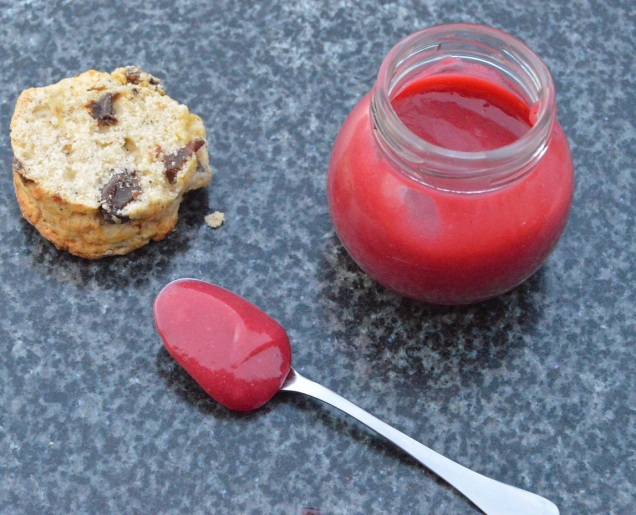Earl Grey Scones With Raspberry Curd
Posted by Gaynor Birkhead on
EARL GREY SCONES WITH RASPBERRY CURD

A little bit of Afternoon Tea in each bite, these light scones are easy to make and even easier to eat! Eaten with clotted cream and a good fruit curd these scones will, I am sure, not hang around for long!
And while a very traditional plain scone with clotted cream and jam is simple perfection for me, I do like the occasional twist.
Tea-infused sultanas
The sultanas have been soaked in tea overnight to plump up nicely as well as adding a good tea flavour. The moisture in the sultanas also helps prevent any of them that are poking out through the scones from burning!
I used Earl Grey here but I am quite partial to Lapsang Souchong for a deep, smokey flavour. However, go for a tea of choice: just brew it very strong so you get the flavour into the sultanas.
A little of the dry tea leaves mixed into the dough add further subtle tea notes.
Fruit curd on scones:
When it comes to scones, strawberry jam is a favourite preserve of mine to use, but I do love a rich, tangy fruit curd. You can buy some excellent curds in supermarkets, but you can often find a wider variety in large garden centres or National Trust shops.
It is, however, easy to make your own and you can make a batch in about 30 minutes. I went for raspberry curd, using raspberries straight from the freezer that had been picked from the allotment last autumn. Frozen raspberries are perfect for this.
Some fruit curd recipes call for using lemon juice on top of the fruit being used but you don’t really want any other flavour getting in the way of the raspberries!
I have given a recipe for raspberry curd below the scone recipe: a family recipe of many decades, it makes more than you need to serve with the scones but I think that is no hardship as you can use it on crumpets, bread, even scooped straight out of the jar…….
Gluten-free version:
You can make these scones gluten-free simply by replacing the self-raising flour with gluten-free self-raising flour. They work just as well.
Recipe: Earl Grey scones with raspberry curd – makes about 16 small scones
70g sultanas
about 100ml hot Earl Grey tea, well brewed
2 teaspoons Earl Grey tea leaves
75g unsalted butter, slightly softened
225g self-raising flour
1 rounded teaspoon baking powder
pinch of salt
35g caster sugar
1 medium free-range egg, beaten
70-80ml whole milk
To glaze:
1 egg, beaten
To serve:
raspberry curd (see recipe below)
clotted cream
(1) Either soak the sultanas in the hot tea overnight or simmer them gently together in a small pan for about 15 minutes and leave to cool fully. The sultanas should have absorbed much of the tea but pour off any excess.
(2) Preheat the oven to 180C(fan). Sift the flour, baking powder and salt into a bowl. Stir in the dry tea leaves and rub in the butter with your fingertips.
(3) Stir in the sugar, sultanas and then add the egg and most of the milk. Bring it all together to form a soft, but not sticky dough, adding more milk as needed.
TOP TIP: in order to keep the scones light is important not to handle the dough too much; a round-bladed knife is an excellent way to bring the dough together in the gentlest manner needed so as not to over-work the dough. Just stir it through the mixture with one hand while rotating the bowl with the other and it will rapidly come together with minimal effort. Then use your hands gently pat into a slightly flattened ball.It is also better having the dough on the stickier side.
(4) Roll out the dough onto a lightly floured surface until about 2cm thick and use a 4cm circular cutter to cut out scones, gently re-rolling and cutting more scones out of the remaining dough as needed. If you want to go for miniature scones, use a 2cm or so cutter but roll the dough out a little thinner (otherwise the scones could topple over while they bake!).
(5) Brush the tops lightly with beaten egg, taking care not to let the egg drip down the sides (which would hinder the rise you are after). Bake in the oven for 10-15 minutes until well risen and golden. Transfer to a wire rack to cool completely.
(6) Split the scones and serve with raspberry curd and clotted cream.

Recipe: raspberry curd (makes 3-4 jars)
500g frozen or fresh raspberries
300g caster sugar
230g unsalted butter, in smallish pieces
5 large eggs plus 2 large egg yolks, beaten together (freeze the remaining white for macarons or meringues later!)
(1) Heat the raspberries in a small pan over a medium heat for a couple of minutes, stirring from time to time to break them up and help release their juice. Strain through a fine sieve into a medium bowl, pressing to get as much as the wonderful juice as you can. NB: you only need to heat the raspberries until they break down. If using fresh raspberries, add a small splash of water to the pan to stop them from catching.
(2) Add the sugar, eggs and butter to the warm raspberry juice, mix well and place over a pan of gently simmering water, making sure the bowl is not touching the water. Stir the mixture well with a wooden spoon until the mixture thickens and just coats the back of the spoon (the consistency of double cream). Be patient: this can take 20-25 minutes or so, or a little quicker if the raspberry juice was hotter.
(3) Remove from the heat and pour into sterilised jars – the curd will thicken further as it cools. Keep in the fridge and use within a couple of weeks.
For other curds, replace the raspberries with fruit of choice:
orange curd: the juice of 5 large oranges (with or without the zest)
lemon curd: the juice of 6 large lemons (with or without the zest)
passion fruit curd: about 400ml passion fruit juice (about 15-20 passion fruit; plus seeds if you want the crunch and extra flavour)
With thanks to our friend Philip at https://bakingfanatic.wordpress.com/ how could we survive without his recipes.
